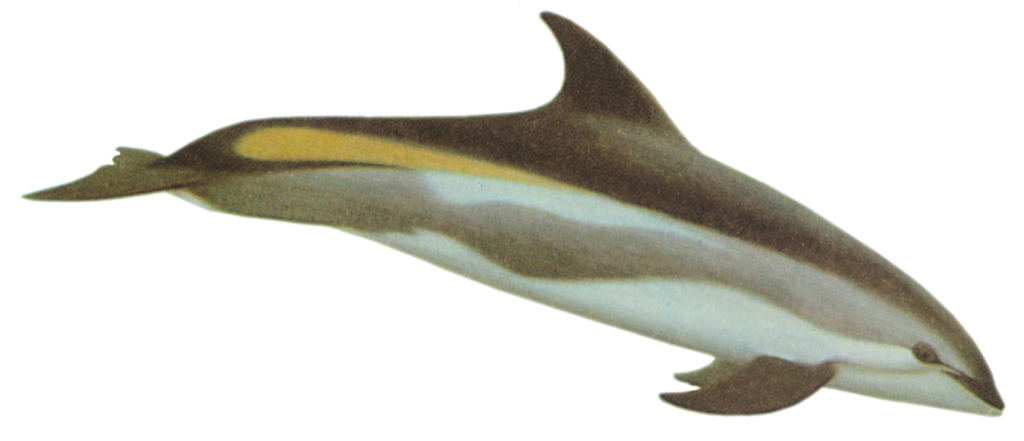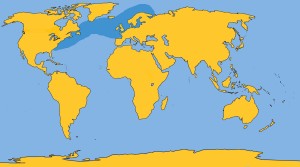 Family: Delphinidae
Family: Delphinidae
Genus: Lagenorhynchus
Species: L. acutus (Gray, 1828)
This strikingly patterned dolphin can be identified by the short, thick stripe on each side of the peduncle, which ranges in color from tan to yellow. Atlantic white-sided dolphins are often found in very large herds up to a thousand individuals, subdivided into pods of 2 to 5 animals. They are avid bow-wave riders and often jump clear of the water as they swim.
Physical Description: They possess a small, poorly demarcated beak. The body is very much like that of the white-beaked dolphin.
Color: The entire dorsal region is black, from the tip of the upper jaw to the flukes. The dark region continues from the juncture of the tail and peduncle toward the head, tapering away midway to the dorsal fin. A thin black line extends from the demarcation of the beak to a circular patch around each eye. The lower flanks are gray from just before the eyes to just past the anus, where two lines meet to encompass the remainder of the underside. The ventral regions are white from the lower jaw to just past the anus. A barely discernible dark streak runs from each eye to the leading margin of the flippers. Within the gray on each flank, a yellowish white patch begins just below the dorsal fin and extends halfway back on the peduncle — this is probably the animal’s most distinctive characteristic.
Fins and Flukes: The falcate dorsal fin is very tall and pointed at the tip. The thin flippers are well developed and pointed. The flukes are well-spread, with a small median notch.
Length and Weight: It reaches 10 ft (3 m) and 420 to 550 lb (190 to 250 kg).
Teeth: Each side of the upper and lower jaw contains 30 to 24 small, sharp, conical teeth.
Feeding: They are known to feed on shrimp, smelt, hake, squid, and herring.
Breathing and Diving: More research is needed to define this category.
Mating and Breeding: A 42 to 48 in (107 to 122 cm) calf is born in spring or midsummer after a 10-month gestation period. Lactation lasts for 18 months; calving occurs every two or three years.
Herding: Usually groups of 10 to 60 when inshore of its range; herds of up to 1,000 have been observed at sea.
Distribution: North Atlantic Ocean from Massachusetts and southern Greenland, east to western Norway and the British Isles.
Migration: No information available.
Natural History Notes: Individual and mass strandings are quite common; these are the more commonly stranded small whales in the New England region of the United States. They are thought to live to at least 27 years.
ATLANTIC WHITE-SIDED DOLPHIN DISTRIBUTION






